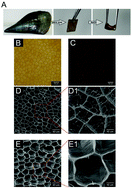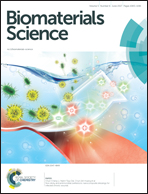Flexible and highly interconnected, multi-scale patterned chitosan porous membrane produced in situ from mussel shell to accelerate wound healing†
Abstract
Utilization of the underlying mechanisms of biological systems is the principal endeavor of biomimetics, the primary goal of which is to treat on-going biological processes. From the perspective of tissue engineering, one purpose of biomimetics is to create highly cellular- or tissue-favored environments for bio-defect repair. Marine creatures such as mussels have inspired bioengineers to design ideal cellular substrates, strong adhesives, and other bioengineering materials. Herein, we report a novel mussel shell-derived membrane for wound dressing. Mussel shell in situ manufactured a highly flexible membrane with a regular porous pattern after the direct action of acid (A-shell) followed by base treatment (B-shell). The SEM images display elegantly patterned polygons with nanowalls (about 710 nm). Compared with the A-shell, the B-shell has a more defined and flexible structure. FTIR characterization of the structures indicates that deacetylation occurred on the B-shell. A cellular toxicity study was conducted to determine the optimized processing parameters before applying the wound healing model. The B-shell significantly closed the wound at an early stage (day 10) followed by complete contraction at a later stage (day 21). This is completely consistent with the higher level of α-SMA protein, which accelerates wound contraction in the wound sites. As a key index of the integration between host and guest, a high blood vessel density was detected in both the A-shell and B-shell groups. The treated shells can improve epidermal migration, the formation of granulation tissue, neovascularization and hair follicles, and reduce scar tissue. Our mussel shell-derived membrane could have potential as a wound dressing and other biomedical uses.



 Please wait while we load your content...
Please wait while we load your content...